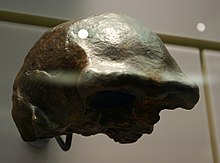
Back Solomens Afrikaans إنسان سولو Arabic Yavantrop Azerbaijani Homo erectus soloensis Catalan Homo soloensis German Homo erectus soloensis Spanish انسان راستقامت سولویی Persian Homme de Solo French Soloski čovjek Croatian Manusia Solo ID
| Solo Man Temporal range: Late Pleistocene
| |
|---|---|

| |
| Cast of Skull XI at the Hall of Human Origins, Washington, D.C. | |
| Scientific classification | |
| Domain: | Eukaryota |
| Kingdom: | Animalia |
| Phylum: | Chordata |
| Class: | Mammalia |
| Order: | Primates |
| Suborder: | Haplorhini |
| Infraorder: | Simiiformes |
| Family: | Hominidae |
| Subfamily: | Homininae |
| Tribe: | Hominini |
| Genus: | Homo |
| Species: | |
| Subspecies: | †H. e. soloensis
|
| Trinomial name | |
| †Homo erectus soloensis Oppenoorth, 1932
| |
| Synonyms[citation needed] | |
| |
Solo Man (Homo erectus soloensis) is a subspecies of H. erectus that lived along the Solo River in Java, Indonesia, about 117,000 to 108,000 years ago in the Late Pleistocene. This population is the last known record of the species. It is known from 14 skullcaps, two tibiae, and a piece of the pelvis excavated near the village of Ngandong, and possibly three skulls from Sambungmacan and a skull from Ngawi depending on classification. The Ngandong site was first excavated from 1931 to 1933 under the direction of Willem Frederik Florus Oppenoorth, Carel ter Haar, and Gustav Heinrich Ralph von Koenigswald, but further study was set back by the Great Depression, World War II and the Indonesian War of Independence. In accordance with historical race concepts, Indonesian H. erectus subspecies were originally classified as the direct ancestors of Aboriginal Australians, but Solo Man is now thought to have no living descendants because the remains far predate modern human immigration into the area, which began roughly 55,000 to 50,000 years ago.
The Solo Man skull is oval-shaped in top view, with heavy brows, inflated cheekbones, and a prominent bar of bone wrapping around the back. The brain volume was quite large, ranging from 1,013 to 1,251 cubic centimetres (61.8 to 76.3 cu in), compared to an average of 1,270 cm3 (78 cu in) for present-day modern males and 1,130 cm3 (69 cu in) for present-day modern females. One potentially female specimen may have been 158 cm (5 ft 2 in) tall and weighed 51 kg (112 lb); males were probably much bigger than females. Solo Man was in many ways similar to the Java Man (H. e. erectus) that had earlier inhabited Java, but was far less archaic.
Solo Man likely inhabited an open woodland environment much cooler than present-day Java, along with elephants, tigers, wild cattle, water buffalo, tapirs, and hippopotamuses, among other megafauna. They manufactured simple flakes and choppers (hand-held stone tools), and possibly spears or harpoons from bones, daggers from stingray stingers, as well as bolas or hammerstones from andesite. They may have descended from or were at least closely related to Java Man. The Ngandong specimens likely died during a volcanic eruption. The species probably went extinct with the takeover of tropical rainforest and loss of preferred habitat, beginning by 125,000 years ago. The skulls sustained damage, but it is unclear if it resulted from an assault, cannibalism, the volcanic eruption, or the fossilisation process.
© MMXXIII Rich X Search. We shall prevail. All rights reserved. Rich X Search